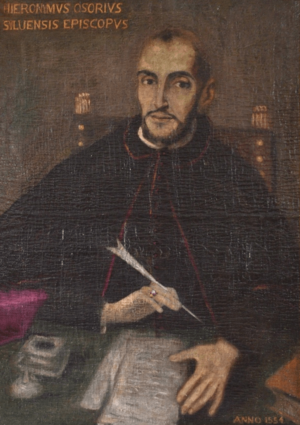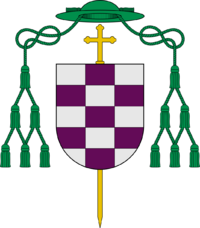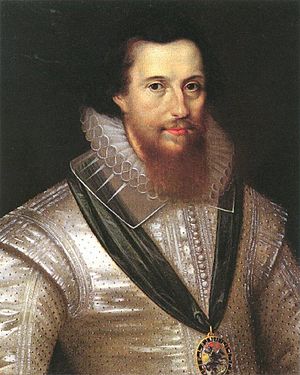Jerónimo Osório facts for kids
Quick facts for kids D. Jerónimo Osório |
|
|---|---|
| Bishop of the Algarve | |
 |
|
| Church | Roman Catholic Church |
| Diocese | Archdiocese of Faro |
| Appointed | 21 June 1564 |
| Reign ended | 20 August 1580 |
| Orders | |
| Consecration | 22 October 1564 by Julião de Alva |
| Personal details | |
| Birth name | Jerónimo Osório da Fonseca |
| Born | 1506 Lisbon, Portugal |
| Died | 20 August 1580 (aged 73–74) Tavira, Portugal |
| Styles of Jerónimo Osório |
|
|---|---|
 |
|
| Reference style | His Lordship |
| Spoken style | Your Lordship |
D. Jerónimo Osório da Fonseca (1506 – 20 August 1580) was an important Portuguese humanist during the Renaissance. He was a bishop, a historian, and a writer who debated ideas. People called him "The Portuguese Cicero" because he was so good at writing in Latin.
Contents
Who Was Jerónimo Osório?
His Early Life and Schooling
Jerónimo Osório was born in Lisbon, Portugal, in 1506. His family was from a noble background. His father, João Osório de Fonseca, was a high-ranking official for the Portuguese government in India.
When Jerónimo was only 13, in 1519, he showed amazing talent for Latin. His mother sent him to Salamanca, Spain, to study law. Two years later, he was very good at both Latin and Greek. He wanted to join the Knights Hospitaller and become a soldier in Rhodes. But his father wanted him to continue his studies.
After his father passed away, Jerónimo decided to follow a religious path instead of a military one.
His Studies and Teachings
In 1525, when he was 19, Jerónimo went to Paris to study logic and natural science. There, he met important religious figures like Peter Faber and Francis Xavier, who were close to Ignatius of Loyola, the founder of the Jesuits.
Later, he went to Bologna to study theology, which is the study of religious faith. He read many works by important early Christian writers, like Augustine of Hippo. He also studied the ideas of Plato.
Because he was so smart, King John III invited him to teach at the University of Coimbra in 1536. He taught about parts of the Bible, like the Book of Isaiah and the letters of St Paul.
Becoming a Famous Writer
In 1540, Jerónimo returned to Lisbon. He became a secretary to Prince Luís and a tutor to his son, António.
Before he was 30, he wrote two important books: De Nobilitate Civili (About Civil Nobility) and De Nobilitate Christiana (About Christian Nobility). These books were published in Lisbon in 1542 and quickly made him famous around the world. His excellent Latin writing style earned him the nickname "The Portuguese Cicero."
After Prince Luís died in 1553, Jerónimo left the royal court. In 1560, he became an archdeacon in Évora. Then, in 1564, he became the Bishop of Silves, which was the main church leader for the Algarve region. He took this role even though he didn't really want it.
Jerónimo Osório and England
Jerónimo Osório was known for speaking out against ideas he disagreed with. He criticized the ideas of Niccolò Machiavelli and also the teachings of Martin Luther.
In 1562, he wrote a letter in Latin to Queen Elizabeth I. In this letter, he asked her to return to the Roman Catholic Church and accept the Pope's authority. This letter was later translated into English as A Pearl for a Prince.
The English government was upset by this public challenge to their Queen. They asked Walter Haddon to write a response. Osório then wrote an even longer reply. This debate became very famous and was read by many people. It was part of a larger conflict between England and the Pope.
Later Years and Legacy
Cardinal Henry, who had helped Osório become bishop, wanted him to work in Lisbon for the government. But Osório said no, explaining that his duties as a bishop were more important.
In 1571, his long History of the reign of King Emmanuel was published. This book told the story of King Emmanuel's time as ruler in detailed Latin. It also included the adventures of Vasco da Gama, the famous explorer. This book came out around the same time as Os Lusíadas, a famous epic poem by his friend Luís Vaz de Camões.
Osório also tried to advise King Sebastian about his plans to go to Africa. He wrote letters trying to convince the King not to go. King Sebastian did not like people who disagreed with his plans. So, Osório decided it was safer to leave Portugal for a while and visit Parma and Rome.
He later returned to his diocese. The main church of his diocese moved from Silves to Faro in 1577. Jerónimo Osório died in Tavira on August 20, 1580.
Osório's Library
It is believed that Osório's personal library was taken from Faro in 1596. This happened when the Earl of Essex raided the town after capturing Cádiz. The Earl of Essex took the library of Dom Fernando Martins Mascarenhas, who was the Bishop of Faro at the time. This library likely contained many of Osório's books.
In 1600, the Earl of Essex gave about 200 books to the Bodleian Library in Oxford. However, none of these books have Bishop Osório's signature. Still, some historians think that certain old manuscripts, like a book by Tomé Pires and a book by the mapmaker Francisco Rodrigues, might have once belonged to Osório.
His Writings
Jerónimo Osório wrote many important works in Latin. Some of his main books include:
- De Nobilitate Civile, et De Nobilitate Christiana (1542): These books discuss what it means to be noble, both in society and as a Christian.
- De Justitia Coelesti (1564): This book was about heavenly justice.
- De Gloria (1568): This book explored the idea of glory.
- De Regis Institutione et Disciplina (1571): This book was about how a king should be educated and disciplined.
- De Rebus Emmanuelis Regis Lusitaniae Invictissimi Virtute et Auspicio Gestis (1571): This was his famous history of King Emmanuel's reign.
- De Vera Sapientia (1578): This book was about true wisdom.
After his death, his nephew collected and published all of his uncle's Complete Works in four volumes in 1592. These collected works included his letters, commentaries on parts of the Bible, and other writings.
His book De Nobilitate was very popular and was translated into Portuguese, French, and English. His Portuguese letters were also published in the 19th century.


